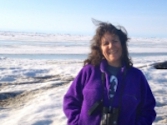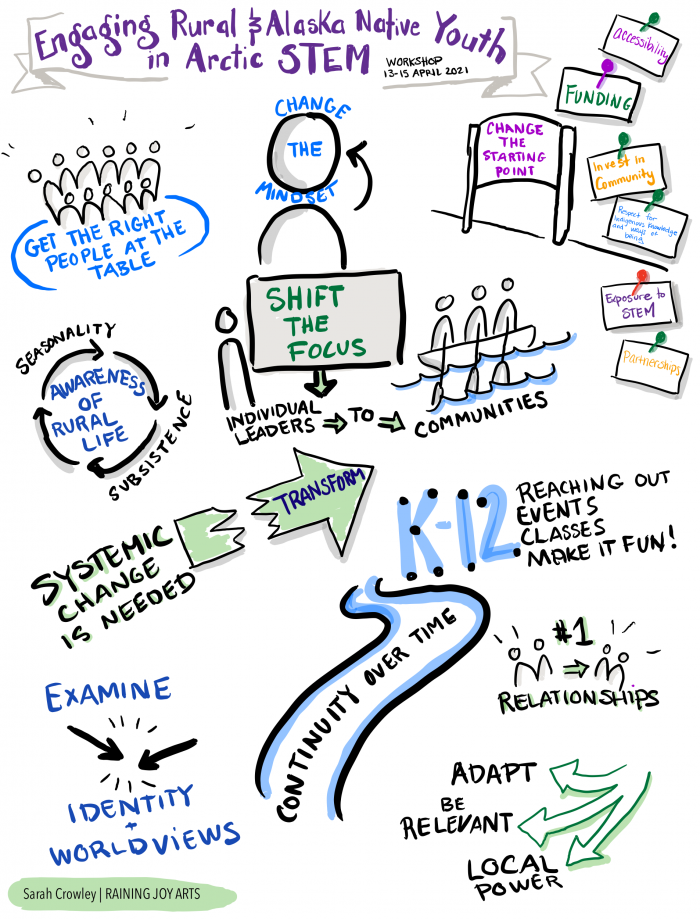By: Janet Warburton, Project Manager, Arctic Research Consortium of the US
The Arctic is undergoing rapid and significant changes. These changes require communities to be aware, informed, and involved to be able to address complex environmental, economic, and social challenges with their associated Arctic science, technology, engineering, and mathematics (STEM) needs. These challenges require a diverse workforce with different backgrounds, perspectives, and knowledge to develop responses to new and emerging issues. In particular, there is a greater need for better representation of rural and Alaska Native undergraduate students in STEM programs to ensure a more diverse Arctic STEM workforce.
To address this issue, the virtual workshop Engaging Rural and Alaska Native Undergraduates and Youth in Arctic STEM was held from 13–15 April 2021. The goal of the workshop was to bring together rural and Alaska Native undergraduates and youth, federal agency representatives, researchers on Arctic STEM projects, Indigenous faculty and staff, those from the private sector, and rural Alaska community members to discuss the gaps, challenges, opportunities, and successful practices to increase and support the representation of rural and Alaska Native undergraduates and youth in STEM education and career pathways (Figure 1).
The workshop was an initiative of the Interagency Arctic Research and Policy Committee (IARPC) Arctic STEM Education Working Group and was hosted by the Arctic Research Consortium of the US (ARCUS) with funding from the National Science Foundation (NSF PLR 1304316 and PLR 1928794). The International Arctic Research Center at the University of Alaska Fairbanks (IARC) was subcontracted to provide support for the planning and execution of the workshop. A series of Listen and Learn Sessions were held before the workshop to set foundational themes and draft recommendations to be discussed and refined during the workshop.
Seventy-three participants attended the three-day workshop, which included a series of plenary sessions and smaller breakout sessions addressing two guiding questions: (1) What can be done to increase rural and Alaska Native undergraduate and youth participation in existing Arctic STEM programs? and (2) What can programs do differently or how can programs adapt to support student engagement?
By the end of the workshop, a nonprioritized list of recommendations was created to respond to these questions. For the preparation of the report, recommendations were synthesized and sorted into seven thematic areas. Below, the full list of recommendations follows each theme.
Theme One: Increase Early Outreach and Exposure to STEM
- Create more preparatory programs that address regional needs and diverse approaches.
- Engage more with high-school freshmen and younger students; existing programs mostly target sophomores and juniors.
- Increase personal engagement and communication. Pay more attention to how we are actually reaching and communicating with students.
- Integrate research into courses in the K–12 system; incorporate citizen science. Make courses relevant to place and culture.
- Time outreach activities appropriately throughout the year, being sensitive to subsistence and/or yearly events already occurring in communities.
Theme Two: Define STEM broadly and inclusively to capture a wider group of students
- Use a broader definition of science and STEM. Be more holistic and have social sciences and humanities integrated. Do not just focus on STEM fields on their own.
- Avoid gatekeeping in science. Make sure an inclusive definition of science is used so that social science and Indigenous knowledge are not excluded. (Gatekeeping is defined as limiting access.)
- Encourage finding ways to integrate STEM identities and Indigenous identities.
- Help—and create programs for—students who do not have a high grade-point average. They need an entry point.
- Encourage students in a variety of programs besides just in STEM. Include the social sciences so that some blending can occur for those with similar interests.
- Consider the needs of nontraditional students.
Theme Three: Redefine how program objectives and success are measured to ensure they are relevant to students and communities
- Make sure scientists, researchers, and STEM program leaders ask themselves:
- What is the purpose of what we are doing? What are the intended and actual outcomes? What do we see students doing, and where do we see them going, after? What are their opportunities and desires, and needs in communities, and how can we align them better?
- Skills needed to conduct scientific work are varied; make sure that the skills students
gain are applicable to other aspects of their lives. - Shift away from individualistic thinking and more toward communal/community-based thinking.
Theme Four: Draw on partnerships with multiple sectors and organizations
- Create more partnerships with industries.
- Work more with existing programs, including the Rural Alaska Honors Institute (RAHI), Alaska Native Science and Engineering Program (ANSEP) and Upward Bound. Continuity in and across programs is important.
- Create a website repository of available programs across Alaska (not just University of Alaska) for educators and students, so that programs are easier to access.
- Encourage better collaboration among STEM programs and organizing entities (e.g., partner with programs or organizations that work with Indigenous youth) from many institutions and not just one institution.
- Work with local Alaska Natives and Native organizations (nonprofit and for-profit) to get better input early on in designing and/or maintaining available programs or grants.
- Help agencies and organizations that work in Alaska but are not based here get an Alaska perspective.
Theme Five: Shift power to students and communities
- Move power to the communities by engaging and involving them early in program design, program recruitment, and making funding decisions.
- Make sure the right people are at the table. If needed, slow down the process to make sure the right people are there. Plan carefully to include extra time that may be needed. This might require challenging federal agencies to institute change in this area.
- Change the starting point of projects so that students, along with communities, drive what projects look like.
Theme Six: Remove hurdles to participation, including structural and systemic hurdles
- Include more thought about and discussion around systemic issues.
- Provide more internet access and bandwidth in communities.
- Incentivize programs so that students want to and are able to participate. Provide livable wages.
Theme Seven: Respect and include Indigenous knowledge and ways of being
- Make relevancy a primary goal and make sure diverse worldviews are considered.
- Be aware of and work flexibly around seasonal subsistence activities and timing, so that students have the capacity to participate in these activities.
A draft of this workshop report was submitted to the steering committee, workshop participants, and broader community members for review and to solicit any additional input before publication. Comments and feedback were incorporated, and the final report has been posted on the ARCUS website, shared publicly, and submitted to the IARPC Arctic STEM Education Working Group, which will look at how the recommendations and highlights can be distilled into actionable items. The IARPC Arctic STEM Education Working Group works to connect STEM education organizations that leverage Arctic science and includes both federal and nonfederal members. The IARPC 2022–2026 Arctic Research Plan includes STEM education as a foundational activity. The outcomes in this workshop report will be useful for federal planning.
The workshop was an initiative of the Interagency Arctic Research and Policy Committee (IARPC) Arctic STEM Education Working Group and was hosted by the Arctic Research Consortium of the US (ARCUS) with funding from the National Science Foundation (NSF PLR 1304316 and PLR 1928794).
Questions about the workshop or the report can be directed to Janet Warburton at warburton [at] arcus.org.
About the Author
 Janet Warburton joined ARCUS in October 2000. Her primary focus as Project Manager is developing and implementing education related projects that help ARCUS meet its mission. For over a decade, she has administered ARCUS' signature education program, PolarTREC - Teachers and Researchers Exploring and Collaborating. She is also currently working The Arctic in the Classroom, a program that focuses on citizen science projects in the Arctic. She is currently ARCUS' representative for University of the Arctic.
Janet Warburton joined ARCUS in October 2000. Her primary focus as Project Manager is developing and implementing education related projects that help ARCUS meet its mission. For over a decade, she has administered ARCUS' signature education program, PolarTREC - Teachers and Researchers Exploring and Collaborating. She is also currently working The Arctic in the Classroom, a program that focuses on citizen science projects in the Arctic. She is currently ARCUS' representative for University of the Arctic.

